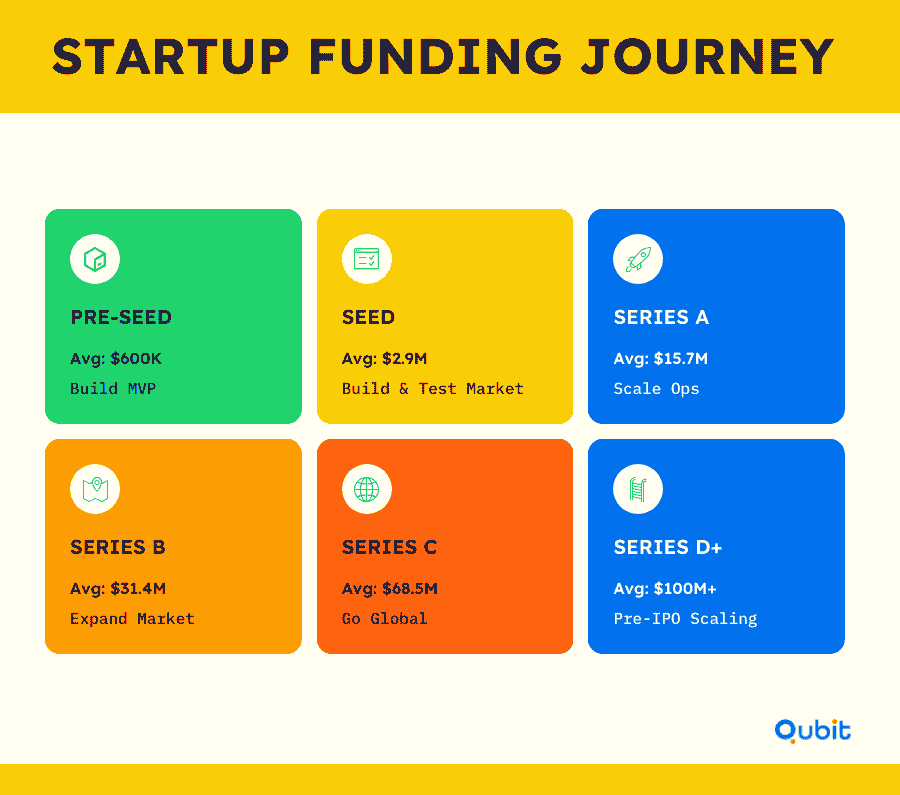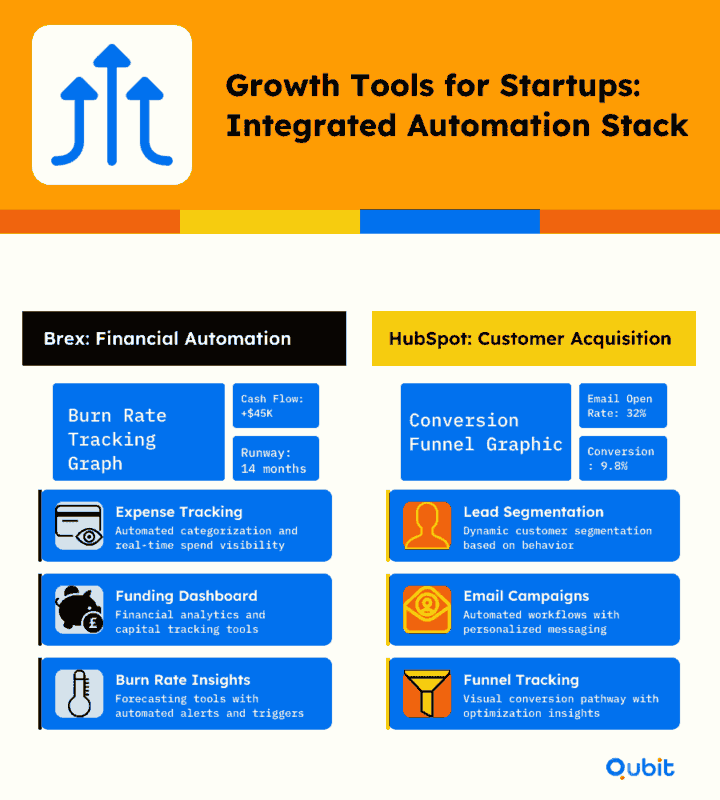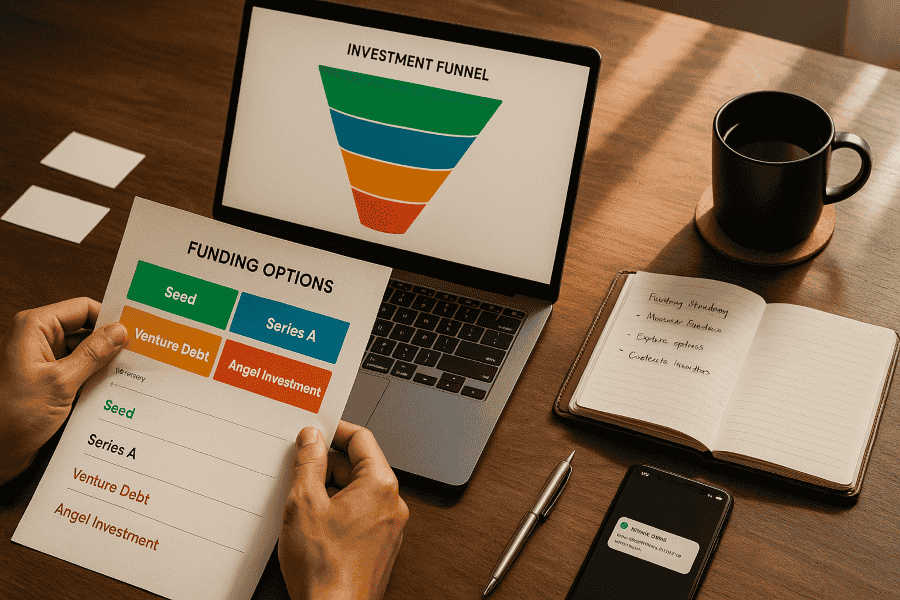Global VC investments hit $314 billion in 2024. That’s a 3% rise year over year, even in a shaky market. Founders are still raising—and raising big.
But venture capital is just one piece of the puzzle. This post breaks down the full range of funding options for startups. From seed rounds to alternative models, you’ll learn how each one works and when to consider it.
Later-stage options like what is venture capital come with bigger checks and stricter expectations. It's important to see how they differ from early-stage routes.
We’ll unpack all of it. From first dollar to final round. Let’s get you the right capital, the right way.
What are the Different Startup Funding Stages?
Startup funding progresses through several stages, each designed to meet specific business needs and growth milestones. Let’s break down the journey from pre-seed to Series E, highlighting typical funding amounts, investor priorities, and the goals you should aim to achieve at each stage.

1. Pre-Seed Funding: Laying the Foundation
Pre-seed funding is often the first step for startups, focusing on validating the initial idea and building a minimum viable product (MVP). At this stage, funding typically comes from personal savings, friends, family, or angel investors. The average pre-seed raise is around $600,000, which is used to cover early operational costs and product development.
Investors at this stage are primarily interested in the founding team’s vision and the potential of the idea. Demonstrating a clear problem-solution fit and a roadmap for product development can help secure this initial capital.
2. Seed Funding: Establishing Product-Market Fit
Seed funding is where startups begin to refine their product and establish product-market fit. The average seed raise is approximately $2.9 million, which is often used to expand the team, enhance the product, and test market traction.
At this stage, investors focus on early market validation, customer feedback, and the scalability of the business model. Every funding journey starts somewhere. What is seed funding explains how that first round helps cover product development, team building, and early market testing.
3. Series A: Scaling Operations
Series A funding is a pivotal stage where startups transition from validation to scaling. The typical Series A raise is around $11.6 million, which is used to optimize operations, expand the customer base, and strengthen the business model.
Investors at this stage expect startups to demonstrate consistent revenue growth, a scalable business model, and a clear path to profitability. Metrics such as customer acquisition cost (CAC) and lifetime value (LTV) become critical in convincing investors of the startup’s potential.
4. Series B: Accelerating Growth
By the time a startup reaches Series B, it is focused on accelerating growth and expanding into new markets. The average Series B raise is approximately $30 million, which is often allocated to hiring, marketing, and infrastructure development.
Investors at this stage look for strong market traction, a proven business model, and the ability to scale operations efficiently.
Some startups look beyond venture funding as they scale. Private equity for startups shows how larger investments can support growth, acquisitions, or strategic shifts in later stages.
5. Series C: Major Growth Initiatives
Series C funding is typically used for major growth initiatives, such as entering international markets, acquiring competitors, or launching new product lines. The average raise for this stage is around $60 million.
At this point, investors expect startups to have a well-established market presence, robust revenue streams, and a clear strategy for scaling further. The focus shifts to long-term growth and preparing for potential IPOs or acquisitions.
6. Series D and Beyond: Late-Stage Expansion
Series D and subsequent funding rounds are geared toward late-stage expansion and IPO readiness. The average Series D raise is approximately $105 million, which is used to fuel large-scale initiatives, such as global expansion or significant R&D investments.
Investors in these rounds are highly focused on financial metrics, market leadership, and the startup’s ability to sustain growth in competitive markets. Late-stage funding has seen a significant rise in recent years, reflecting the growing emphasis on IPO preparation and market dominance.
Key Metrics Investors Evaluate
Across all funding stages, certain metrics remain critical in securing investor confidence:
- Market Traction: Demonstrating strong customer adoption and retention rates.
- Revenue Metrics: Showing consistent revenue growth and profitability potential.
- Burn Rate: Managing spending efficiently to ensure sustainable growth.
- Product-Market Fit: Proving that your product meets a significant market need.
Planning Your Capital-Raising Journey
Understanding the expectations and objectives of each funding stage can help you craft a strategic approach to capital raising. Whether you’re just starting out or preparing for an IPO, aligning your goals with investor priorities is essential for long-term success.
If you’re ready to take the next step in your funding journey, Qubit Capital offers tailored fundraising assistance to help startups secure the capital they need.
Diversify Your Startup Capital with Alternative Funding
Securing funding is one of the most critical steps for any startup, but relying solely on traditional equity rounds can dilute ownership and limit flexibility. Exploring alternative funding methods can provide startups with diverse capital options tailored to their unique needs and growth stages. From government-backed loans to crowdfunding and equity-free financing, these options can complement or even replace equity-driven rounds, offering founders more control over their ventures.
1. Government-Backed Loans: A Reliable Starting Point
For startups seeking low-risk funding, government-backed loans, such as those offered by the U.S. Small Business Administration (SBA), can be an excellent choice. These loans provide favorable terms, including lower interest rates and extended repayment periods, making them ideal for early-stage businesses. The SBA offers various programs tailored to different needs, from microloans to larger 7(a) loans. To explore these options, visit the SBA Loans page, which details their small business loan programs and includes tools like a loan finder widget to simplify the process.
Not all funding means giving up equity. Government grants for startups offer non-dilutive support that helps you build without handing over ownership.
2. Crowdfunding: Harnessing Community Support
Crowdfunding has emerged as a popular way for startups to raise capital while building a loyal customer base. Platforms like Kickstarter and Indiegogo allow entrepreneurs to pitch their ideas directly to the public, offering rewards or pre-orders in exchange for funding. This method not only provides financial support but also validates market demand for your product or service.
Some founders turn to their audience instead of institutions. Crowdfunding for startups taps into public support, letting customers and early believers fund the next stage.
3. Equity-Free Financing: Preserving Ownership
Equity-free financing options, such as revenue-based financing, are gaining traction among startups that prioritize maintaining ownership. Platforms like Republic and Pipe offer innovative solutions. Republic provides funding in exchange for recurring revenue, allowing startups to access capital without giving up equity. Similarly, Pipe facilitates upfront capital by enabling businesses to sell their recurring revenue contracts.
These models are particularly appealing for startups with predictable revenue streams, as they offer flexibility and preserve founder control. Integrating tools like Republic’s widget into your funding portal can streamline the process of securing equity-free financing.
4. Angel Investors: Strategic Private Capital
Angel investors are individuals who provide capital to startups in exchange for equity or convertible debt. Beyond funding, they often bring valuable expertise and networks to the table, making them a strategic choice for early-stage businesses.
Many early-stage startups rely on individuals rather than firms. What are angel investors explains how private capital can provide both funding and mentorship in those first critical steps.
5. Short-Term Loans and Credit Cards: Bridging Financial Gaps
For startups needing quick access to funds, short-term loans and business credit cards can be effective solutions. While these options typically come with higher interest rates, they offer immediate liquidity, making them suitable for covering operational expenses or seizing time-sensitive opportunities. However, it’s crucial to evaluate the repayment terms and risks associated with these methods.
Some founders choose to borrow instead of raise. Debt financing for startups gives you access to capital without giving up equity, though it comes with repayment terms you’ll need to manage carefully.
6. Incubators and Accelerators: Beyond Financial Support
Incubators and accelerators provide startups with more than just funding. These programs offer mentorship, resources, and networking opportunities, often in exchange for a small equity stake. They are particularly beneficial for early-stage startups looking to refine their business models and scale quickly.
Why Diversification Matters
Relying on a single funding source can limit your startup’s potential and increase financial risk. By diversifying your capital sources, you can tailor your funding strategy to your business’s specific needs, whether that means preserving equity, accessing quick liquidity, or securing long-term, low-cost financing. Exploring creative financial strategies beyond conventional debt and equity options can open new doors for growth. Some founders mix grants, revenue share, and partnerships instead of leaning on loans or equity. You’ll find plenty of those paths mapped in the context of alternative funding for startups, where flexibility matters more than convention.
Automate Finance and Marketing with Growth Tools
Streamlining operations is essential for startups aiming to scale efficiently. Financial and marketing automation platforms like Brex and HubSpot offer powerful solutions to simplify cash flow management and enhance customer acquisition strategies. These tools integrate seamlessly, enabling businesses to focus on growth without being bogged down by manual processes.

Financial Automation: Simplifying Cash Flow Management
Managing finances can be a daunting task for startups, but Brex has emerged as a popular choice for credit management. With 1 in 3 startups relying on Brex for their financial needs, it’s clear that automation is transforming how businesses handle cash flow. Brex combines expense tracking, credit management, and funding dashboards into one cohesive platform, making it easier to monitor and optimize financial health. For instance, startups can use Brex Stats to display critical financial data directly on funding dashboards, ensuring transparency and informed decision-making.
Marketing Automation: Enhancing Customer Acquisition
On the marketing front, HubSpot stands out as a comprehensive CRM platform that integrates marketing, sales, and customer service tools. By automating tasks like email campaigns, lead tracking, and customer segmentation, HubSpot empowers startups to build stronger relationships with their audience. Its ability to centralize data and provide actionable insights ensures that businesses can target the right customers at the right time, driving higher conversion rates.
The Power of Integration
The synergy between financial and marketing automation tools is where the real magic happens. Platforms like Brex and HubSpot work together to create a streamlined workflow that connects financial data with customer relationship management. This integration not only boosts operational efficiency but also provides startups with the insights needed to make strategic decisions.
By adopting these growth solutions, startups can focus on scaling their operations while maintaining control over their finances and marketing efforts.
Conclusion
Startup funding isn’t one-size-fits-all. Each stage needs a different approach. Early on, it's about bootstrapping, friends and family, or small angel checks. As you grow, VCs, private equity, or strategic investors come into play. We also explored alternative options—like revenue-based financing, crowdfunding, and venture debt. These can offer more flexibility, less dilution, or quicker access. The key is timing and fit.
Know your runway, growth plans, and investor expectations. Don’t just chase the biggest check. Choose what matches your stage and goals. Funding should fuel the next step, not become the focus. Stay clear on why you’re raising and what success looks like. That’s how you make smart, sustainable moves.
At Qubit Capital, we understand the challenges startups face in securing the right funding. If you're ready to develop a winning fundraising strategy, our Fundraising Assistance service is here to help you craft a compelling narrative that resonates with investors and drives results.
Key Takeaways
- Global venture capital investment hit $314 billion in 2024, up 3% year-over-year despite market turbulence.
- Startup finance progresses through stages from pre-seed MVP validation to late-stage expansion and IPO readiness.
- Investors prioritize metrics like CAC to LTV ratios, revenue growth, burn rate management and proven product–market fit.
- Alternative non-dilutive funding such as government loans, grants, crowdfunding and revenue-based financing preserves founder equity.
- Integrating platforms like Brex for finance and HubSpot for marketing automation streamlines operations and enables data-driven scaling.
Frequently asked Questions
Which metrics do investors prioritize?
Investors look at market traction, revenue growth consistency, burn-rate efficiency, unit economics (CAC vs. LTV), customer churn rates, and proof of product-market fit.


 Back
Back



